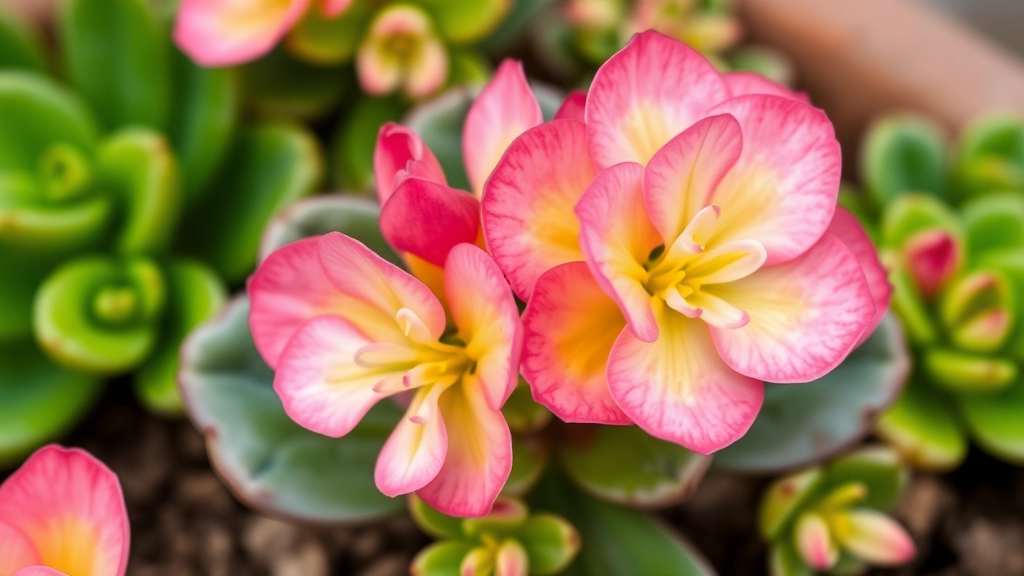Growing and Maintaining Flowering Kalanchoe Succulent
If you’re looking to add a burst of colour and life to your indoor or outdoor garden, the flowering Kalanchoe succulent is a fantastic choice. This resilient plant is not only visually appealing but also relatively easy to care for, making it perfect for both novice and experienced gardeners. Let’s dive into the essential tips for growing and maintaining a thriving flowering Kalanchoe succulent.
Ideal Growing Conditions
First things first, understanding the ideal growing conditions is crucial. Flowering Kalanchoe succulents thrive in well-draining soil and require a good balance of light and temperature to bloom beautifully. Proper watering techniques are also key to preventing root rot, a common issue with succulents. With the right care, your Kalanchoe can become a stunning focal point in your garden or home.
Are you struggling to get your Kalanchoe to bloom? Understanding the ideal growing conditions for flowering Kalanchoe can make all the difference.
Kalanchoe plants thrive in specific environments that mimic their native habitat. Here are the key factors to consider:
## Light Requirements
– **Bright, Indirect Light**: Kalanchoe loves bright light but can suffer from direct sunlight, which may scorch its leaves.
– **Duration**: Aim for at least 6 hours of light daily to encourage blooming.
## Temperature
– **Warm Temperatures**: Ideally, Kalanchoe prefers temperatures between 18°C to 24°C (65°F to 75°F).
– **Avoid Cold Drafts**: Protect your plant from cold drafts and sudden temperature changes, which can hinder growth.
## Humidity
– **Moderate Humidity**: Kalanchoe does well in average humidity levels. If your home is too dry, consider misting occasionally.
## Location
– **Indoor vs Outdoor**: Kalanchoe can thrive indoors or outdoors, but ensure it’s sheltered from harsh conditions. A south-facing window is often ideal.
## Potting
– **Container Choice**: Use a pot with drainage holes to prevent waterlogging, as Kalanchoe is susceptible to root rot.
For more detailed information, you might find the [ultimate guide to flowering Kalanchoe care](https://planthq.org/ultimate-guide-to-flowering-kalanchoe-care-tips-for-blooming/) helpful. Additionally, if you’re dealing with post-flowering issues, check out these [care tips for Kalanchoe after blooming](https://planthq.org/care-tips-for-kalanchoe-after-blooming/).
Essential Light and Temperature Requirements
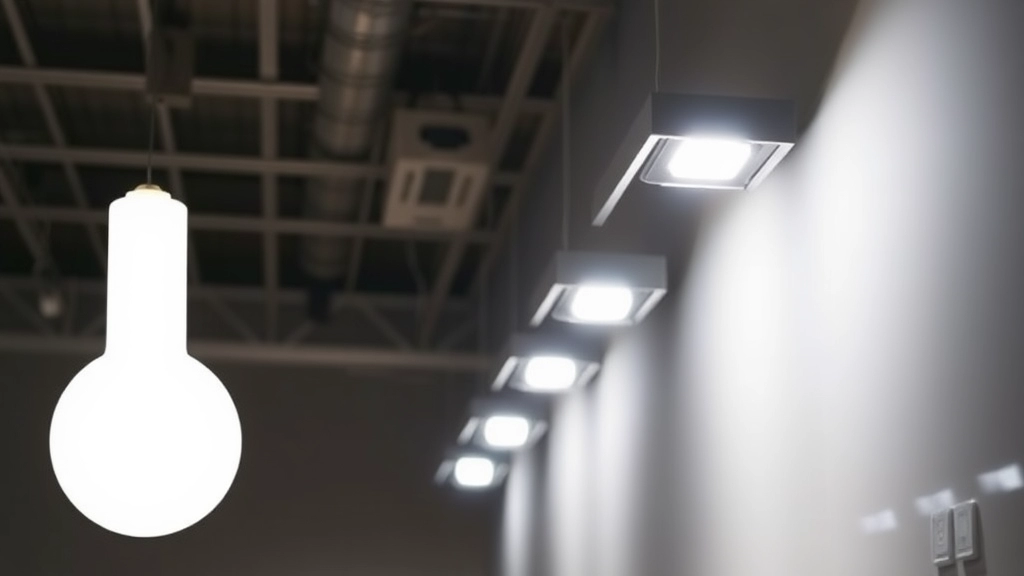
Have you ever wondered why your Kalanchoe isn’t blooming as beautifully as you’d hoped?
One of the biggest factors is getting the light and temperature just right.
Light Requirements
Kalanchoe plants thrive in bright, indirect sunlight.
They love soaking up those rays, but too much direct sun can scorch their leaves.
Here’s what you should keep in mind:
- Ideal Spot: A south or east-facing window is perfect.
- Duration: Aim for about 6 hours of light daily.
- Signs of Too Much Sun: Look out for yellowing leaves or crispy edges.
Temperature Needs
Temperature plays a crucial role in the health of your Kalanchoe.
These plants prefer a cozy environment.
Here are some quick tips:
- Optimal Range: Keep them between 18°C to 24°C (65°F to 75°F).
- Avoid Sudden Changes: Drafts and extreme temperature swings can stress your plant.
- Winter Care: If it gets too cold, bring them indoors to protect them from frost.
Watering Techniques to Prevent Root Rot
Many plant enthusiasts often wonder why their beloved Kalanchoe succumbs to root rot despite their best efforts.
Understanding the watering techniques that suit this resilient succulent can make all the difference.
Key Watering Principles
- Frequency:
- Water your Kalanchoe every 2-3 weeks during the growing season.
- In winter, reduce watering to once a month as the plant enters dormancy.
- Soil Check:
- Always check the top inch of the soil. If it feels dry, it’s time to water.
- Avoid a rigid schedule; adjust based on environmental conditions.
- Watering Method:
- Use the âsoak and dryâ method. Water thoroughly until it drains from the bottom.
- Ensure excess water is not left in the saucer, as this can lead to root rot.
Signs of Overwatering
- Yellowing leaves
- Wilting despite moist soil
- A musty smell from the pot
If you notice these signs, it’s crucial to act quickly.
Best Practices
- Potting: Choose pots with drainage holes to allow excess water to escape.
- Water Quality: Use room temperature water to avoid shocking the roots.
- Humidity: Kalanchoe thrives in low humidity; avoid misting the leaves.
For more detailed guidance on caring for your Kalanchoe, check out our complete guide to Kalanchoe Tomentosa care. Additionally, if you’re dealing with specific issues like drooping leaves, our article on fixing drooping Kalanchoe leaves can provide valuable solutions.
Best Soil Mixes for Kalanchoe Plants
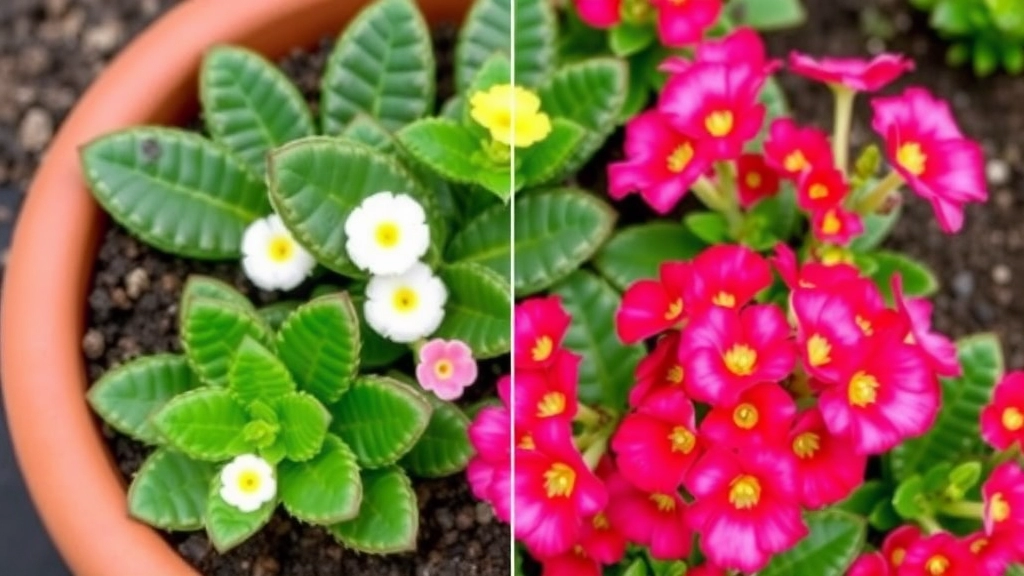
When it comes to nurturing your Kalanchoe, the right soil mix can make all the difference.
Many plant enthusiasts often wonder, “What type of soil is best for Kalanchoe?”
Key Soil Characteristics
Kalanchoe plants thrive in well-draining soil that provides the right balance of moisture retention and aeration.
- Drainage: Kalanchoe roots are prone to rot if they sit in waterlogged soil. Look for a mix that drains quickly.
- Aeration: A good mix allows air to circulate around the roots, promoting healthy growth.
- Nutrient Content: While Kalanchoe isn’t overly demanding, a soil mix with some organic matter can support blooming.
Recommended Soil Mixes
Creating the ideal soil for your Kalanchoe can be straightforward. Here are a few effective combinations:
- Cactus Mix:
- Use a pre-packaged cactus or succulent mix.
- These mixes often contain sand or perlite for enhanced drainage.
- DIY Mix:
- Combine equal parts of:
- Potting soil
- Perlite or pumice
- Coarse sand
- This blend ensures excellent drainage while retaining some moisture.
- Combine equal parts of:
- Orchid Bark:
- Adding orchid bark can improve aeration.
- Mix it with potting soil for a more textured environment.
Tips for Soil Preparation
- Check pH Levels: Kalanchoe prefers slightly acidic to neutral soil (pH 6.0-7.0).
- Avoid Heavy Soils: Stay away from dense, clay-based soils which can retain too much moisture.
- Refresh Your Mix: If your Kalanchoe is in the same soil for years, consider repotting with fresh mix to replenish nutrients.
Fertilization Strategies for Better Blooms
When it comes to nurturing your flowering Kalanchoe, fertilization plays a pivotal role in ensuring vibrant blooms. You may wonder, “How can I boost my Kalanchoe’s flowering potential?” Let’s dive into effective strategies that can make a significant difference.
Understanding Nutritional Needs
Kalanchoe plants thrive on a balanced diet. To achieve stunning blooms, consider the following:
- Use a Balanced Fertiliser: Opt for a water-soluble fertiliser with an N-P-K ratio of 10-10-10 or 15-15-15. This ensures that your plant receives equal parts nitrogen, phosphorus, and potassium.
- Dilution is Key: Always dilute the fertiliser to half the recommended strength. This prevents over-fertilisation, which can lead to leaf burn.
- Frequency Matters: Fertilise every 4-6 weeks during the growing season (spring and summer). This regular feeding encourages robust growth and prolific blooming.
Timing Your Fertilisation
Knowing when to fertilise is just as critical as how to do it. Here’s a simple timeline:
- Start in Early Spring: Begin fertilising as new growth appears in spring.
- Cut Back in Autumn: Reduce feeding as the plant enters dormancy in autumn.
Organic Options
If you’re inclined towards organic gardening, consider these alternatives:
- Compost Tea: Diluted compost tea can provide a gentle nutrient boost.
- Fish Emulsion: This is rich in nitrogen and can help promote leafy growth.
Signs of Nutrient Deficiency
Be attentive to your Kalanchoe’s health. Here are some signs that it may need more nutrients:
- Yellowing Leaves: This can indicate a lack of nitrogen.
- Poor Flower Production: If blooms are sparse, it might be time to reassess your fertilisation strategy.
For more detailed tips on ensuring your Kalanchoe thrives, check out our Ultimate Guide to Flowering Kalanchoe Care Tips for Blooming. Additionally, if you’re facing issues with your plant not flowering, you might find our article on Why Your Kalanchoe is Not Flowering: Causes and Solutions helpful.
How to Prune and Shape a Kalanchoe
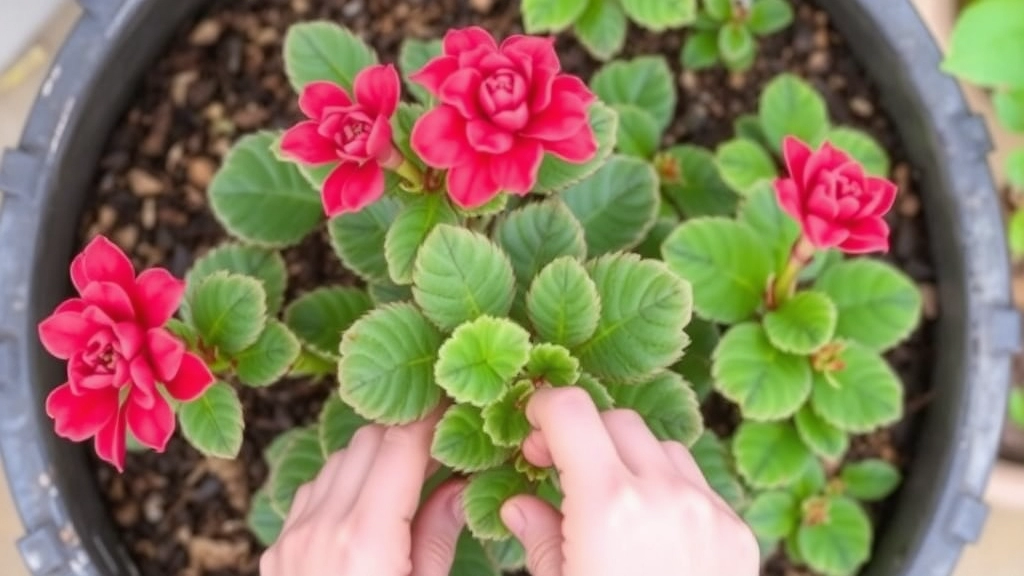
So, you’ve got your Kalanchoe thriving and blooming beautifully. But what happens when those stems get a bit too leggy or the flowers start to fade? Pruning is your secret weapon to keep your plant looking its best and encourage new growth.
Why Prune?
You might be wondering why pruning is essential. Here’s the scoop:
- Encourages bushier growth: Snipping back those leggy stems makes room for new shoots.
- Promotes blooming: Deadheading spent flowers can trigger your Kalanchoe to produce more blooms.
- Keeps it healthy: Removing any dead or diseased leaves prevents pests and diseases from taking hold.
When to Prune
Timing is everything!
- After flowering: The best time to prune is right after your Kalanchoe has finished its blooming cycle.
- Spring is ideal: As the growing season kicks in, it’s the perfect time to shape your plant.
How to Prune
Let’s break it down into simple steps:
- Gather your tools: You’ll need clean, sharp scissors or pruning shears.
- Identify what to cut:
- Remove dead or yellowing leaves.
- Snip back any leggy stems to just above a leaf node.
- Deadhead spent flowers by cutting them off at the base of the flower stem.
- Make clean cuts: This helps prevent damage and disease.
- Shape as you go: Aim for a balanced look, trimming evenly around the plant.
Post-Pruning Care
After you’ve pruned, give your Kalanchoe a little TLC:
- Water lightly: Don’t drown it; just a light sprinkle to keep the soil moist.
- Avoid direct sunlight: Let it recover in a spot with bright, indirect light for a few days.
By following these tips, you’ll have a Kalanchoe that’s not just healthy but also stunningly shaped.
Propagation Methods: Seeds, Cuttings, and Division
Now that we’ve explored how to care for your Kalanchoe, let’s delve into propagation methods. Many enthusiasts wonder how to expand their collection or share their plants with friends.
Propagation Methods for Kalanchoe:
- Seeds:
- Collect seeds from mature flowers once they have dried.
- Sow seeds in a well-draining soil mix, lightly covering them.
- Keep the soil moist but not soggy.
- Place in a bright location, ensuring they receive indirect sunlight.
- Germination typically occurs within a few weeks.
- Cuttings:
- Choose healthy stems from a parent plant.
- Use clean, sharp scissors to take cuttings that are about 10-15 cm long.
- Allow cuttings to dry for a day or two to form a callus.
- Plant in a sandy, well-draining soil mix.
- Water lightly and place in bright, indirect light.
- Roots should develop in a few weeks.
- Division:
- This method works best for mature Kalanchoe plants.
- Carefully remove the plant from its pot and gently separate the root ball.
- Ensure each division has roots and a few leaves.
- Replant each division in its own pot with fresh soil.
- Water thoroughly and place in a suitable light environment.
By employing these propagation techniques, you can easily multiply your Kalanchoe plants or share them with fellow plant lovers. For more detailed guidance, check out our [guide on how to propagate Kalanchoe Mother of Thousands](https://planthq.org/how-to-propagate-kalanchoe-mother-of-thousands-easily/) and learn the [optimal watering tips for healthy Florist Kalanchoe](https://planthq.org/optimal-watering-tips-for-healthy-florist-kalanchoe/).
Common Pests and How to Manage Them
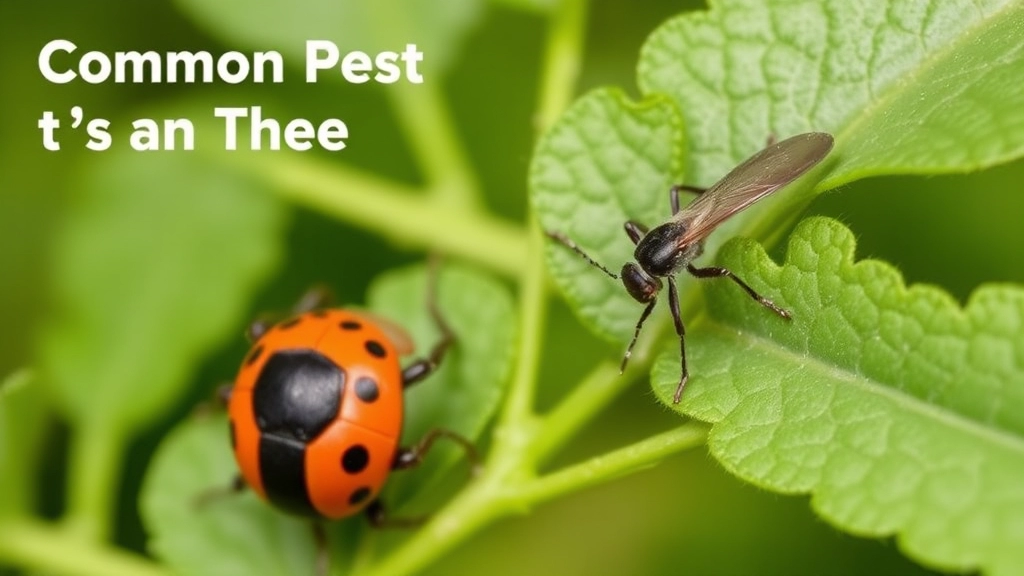
Have you noticed some odd spots on your Kalanchoe leaves or maybe a sticky residue?
Pests can be a real headache for plant lovers, but don’t worry, I’ve got your back.
Common Pests to Watch Out For:
- Mealybugs: These little white cottony pests love to hide in the leaf axils.
- Aphids: Tiny green or black bugs that suck the sap, causing leaves to curl.
- Spider Mites: These minuscule creatures thrive in dry conditions and leave fine webbing.
- Scale Insects: They look like small bumps on stems and leaves, sucking the life out of your plant.
How to Manage Them:
- Inspect Regularly: Check your Kalanchoe weekly for any signs of pests.
- Keep It Clean: Wipe leaves with a damp cloth to remove dust and pests.
- Use Neem Oil: A natural pesticide that’s safe for your plant. Just mix it with water and spray.
- Insecticidal Soap: This can help eliminate soft-bodied insects like aphids and mealybugs.
- Introduce Beneficial Insects: Ladybugs and lacewings are natural predators to many common pests.
After nurturing your Kalanchoe through its initial blooming phase, you may find yourself wondering how to coax those vibrant flowers back for another round.
### Understanding Reblooming Needs
Kalanchoe plants, known for their stunning clusters of flowers, can indeed rebloom with the right care. Here are some effective strategies to encourage your Kalanchoe to showcase its beauty once more:
– **Prune After Blooming:** Once the flowers fade, trim back the stems to promote new growth. This helps redirect the plant’s energy towards producing new blooms.
– **Adjust Light Exposure:** Kalanchoe thrives in bright, indirect sunlight. Ensure your plant receives at least 6 hours of light daily. If it’s too shaded, it may not bloom again.
– **Control Watering:** Allow the soil to dry out between waterings. Overwatering can lead to root rot, which hinders blooming. Ensure proper drainage to keep your Kalanchoe healthy.
– **Fertilize Wisely:** Use a balanced, water-soluble fertiliser during the growing season. Fertilising every few weeks can provide the nutrients necessary for reblooming.
– **Temperature Regulation:** Keep your Kalanchoe in a warm environment, ideally between 18°C and 24°C. Sudden temperature drops can stress the plant and inhibit blooming.
– **Create a Dormancy Period:** After the first bloom, allow your Kalanchoe to rest for about six weeks with reduced watering and minimal fertilisation. This rest period can trigger the next blooming cycle.
– **Encourage Darkness:** For some varieties, providing a period of darkness (around 14 hours) can stimulate blooming. Cover the plant or move it to a darker location during this time.
By implementing these straightforward tips, you can help your Kalanchoe flourish and bloom again, adding vibrant colour to your space. For more detailed advice on how to make your Kalanchoe flower again, you can visit our comprehensive guide.
Additionally, if you’re curious about the different varieties and their specific care needs, check out our top Kalanchoe succulent varieties and care tips for more information.
FAQs on Flowering Kalanchoe Succulent
What light conditions are best for a Kalanchoe?
Kalanchoe plants thrive in bright, indirect sunlight. They love soaking up rays, but too much direct sun can scorch their leaves. Aim for about 6 hours of light daily, ideally from a south or east-facing window.
What temperature range is ideal for Kalanchoe plants?
Temperature plays a crucial role in the health of your Kalanchoe. These plants prefer to be kept between 18°C to 24°C (65°F to 75°F). Avoid sudden temperature changes and drafts, and bring them indoors if it gets too cold.
What type of soil is best for Kalanchoe?
Kalanchoe plants thrive in well-draining soil. A cactus or succulent mix is ideal, or you can create a DIY mix with equal parts potting soil, perlite or pumice, and coarse sand. Ensure the soil is slightly acidic to neutral (pH 6.0-7.0).
How should I prune my Kalanchoe?
Pruning is essential for encouraging bushier growth and promoting blooming. The best time to prune is right after the blooming cycle, ideally in spring. Use clean, sharp scissors or pruning shears to remove dead leaves, leggy stems, and spent flowers.
How do I manage common pests on my Kalanchoe?
Common pests include mealybugs, aphids, spider mites, and scale insects. Regularly inspect your plant, keep it clean by wiping leaves, and use natural pesticides like neem oil. Insecticidal soap and beneficial insects like ladybugs can also help control infestations.
How often should I water my Kalanchoe?
Water your Kalanchoe when the top inch of soil feels dry. Be careful not to overwater, as this can lead to root rot. A light sprinkle after pruning helps keep the soil moist without drowning the plant.
Can I grow Kalanchoe indoors?
Yes, Kalanchoe can be grown indoors. Ensure they receive bright, indirect sunlight and are kept in a temperature-controlled environment. Avoid placing them in drafty areas or spots with extreme temperature fluctuations.
What are signs that my Kalanchoe is getting too much sun?
If your Kalanchoe is receiving too much direct sunlight, you might notice yellowing leaves or crispy edges. Move the plant to a spot with bright, indirect light to prevent further damage.
How can I improve soil aeration for my Kalanchoe?
To improve soil aeration, you can add components like perlite, pumice, or orchid bark to your soil mix. These materials help air circulate around the roots, promoting healthy growth.
What should I do if my Kalanchoe is not blooming?
Ensure your Kalanchoe is getting the right amount of light and is in the correct temperature range. Also, check the soil for proper drainage and nutrient content. Pruning can also encourage new blooms by removing spent flowers.
References
-
Kalanchoe Light and Temperature Requirements
-
Best Soil Mixes for Kalanchoe Plants
-
How to Prune and Shape a Kalanchoe
